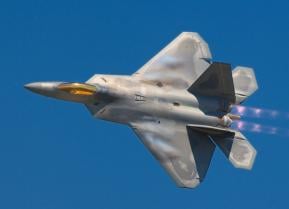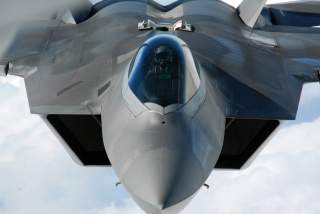A Russian Su-35 Took a Picture of an F-22 Raptor (And It Might Be a Really Big Deal)
An individual purported to be the pilot of a Russian Sukhoi Su-35S has posted a photo that is alleged to the a U.S. Air Force F-22A Raptor that supposedly was captured on the Flanker-E’s OLS-35 electro-optical infra-red search and track system.
Important Point: At close ranges, the Raptor will appear on infrared sensors just like any other aircraft.
An individual purported to be the pilot of a Russian Sukhoi Su-35S has posted a photo that is alleged to the a U.S. Air Force F-22A Raptor that supposedly was captured on the Flanker-E’s OLS-35 electro-optical infra-red search and track system.
(This first appeared several months ago.)
It is not clear if the photo is genuine or sort of attempt at disinformation. However, there is not much that can be gleaned from the information presented. Without the context under which the image was taken, it is impossible to make any real judgments.
However, at close ranges, it is indeed possible that a Raptor—even with the F-22’s reduced infrared signature—would appear on the Su-35 electro-optical infrared sensors as it appears to be the case here (assuming the photo is genuine). Even civilian electro-optical infrared systems made by FLIR Systems can resolve a F-22 at close ranges as can be seen here in this video taken during the 2010 Farnborough Air Show. The fact is that the F-22 was designed to defeat infrared search and track from beyond visual ranges distances not at point blank range.
At close ranges, the Raptor will appear on infrared sensors just like any other aircraft. In previous years such as during exercises in 2009, the Raptor has been captured in air-to-air footage shot from French Rafales using their Optronique secteur frontal (OSF) electro-optical/infrared search and track systems. Meanwhile, during Red Flag Alaska in 2012, German Luftwaffe pilots flying the Eurofighter Typhoon noted that they could acquire a track on the Raptor at ranges of about 20 nautical miles using their EuroFIRST PIRATE infrared search and track.
The OLS-35 is not as capable as the PIRATE, but it is a decent sensor. According to Sukhoi, the Su-35’s OLS-35 infrared sensor can track up to four targets simultaneously at head-n ranges of 50km (27 nautical miles) and tail chase ranges of 90km (49 nautical miles). The system’s precise range depends on the aspect angle and other factors such as atmospheric conditions. The system also incorporates a laser which can precisely measure target ranges at 20km or roughly (11 nautical miles).
Ultimately, it is long-wave infrared search and track—which can track stealth aircraft from extended ranges—that poses the greatest threat to aircraft such as the F-22. The U.S. Navy’s Block II IRST pod—combined with high-speed data-networks and advanced sensor fusion algorithms—is explicitly designed to be a long-range counter-stealth capability. “Can’t talk about specific experiments and specific threats, but IRST is designed to be a long-range counter-stealth technology,” Capt. David ‘DW’ Kindley, the Naval Air Systems Command’s (NAVAIR) F/A-18 and EA-18G Program Office (PMA-265) program manager, told reporters in May.
The fact of the matter is that aircraft moving through the atmosphere will generate heat. “If the enemy aircraft coming at you is low radar cross section—low radar signature—it is still emitting a heat signature,” Bob Kornegay, Boeing’s capture team leader for domestic F/A-18E/F and EA-18G programs, told reporters in May. “So it helps us as the enemies are starting to develop their stealth aircraft. It helps us to defeat that by moving outside of that X-band range.”
Recommended: What Will the Sixth-Generation Jet Fighter Look Like?
Recommended: Imagine a U.S. Air Force That Never Built the B-52 Bomber
Recommended: Russia's Next Big Military Sale - To Mexico?
Recommended: Would China Really Invade Taiwan?
While infrared has traditionally not had the ability generate range data for a weapons quality track, modern data-networks and computer algorithms have changed that. “If you have a single IRST ship, with your IRST, you can get a line of bearing—it’s going to see a hot spot out there, what direction it’s in, but it doesn’t have the distance. You don’t have a weapons quality track,” Kornegay said. “Now if you combine two aircraft, the fusion algorithm, now you have lines of bearing from two different sources. Where those two sources cross, the algorithm is going to compute a weapons quality track on that aircraft. So that’s a huge advantage for the warfighter to see that long before you’re in the enemy’s radar range.”
The Pentagon will likely have to take into account infrared as a potential threat to stealth aircraft as it develops the requirements for future fighter aircraft.
Dave Majumdar is the former defense editor for the National Interest.


